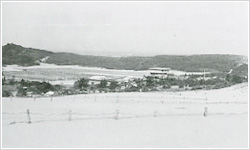History
| 1923 | The Agricultural Collage of Tottori, the predecessor of the current Faculty of Agriculture, Tottori University, established the Koyama Sand Dune Research Experimental Station and started conducting research on planting trees to control sand drifting. |
|---|---|
| 1949 | Simultaneously with the establishiment of Tottori University, research on agricultural development of sand dune areas was commenced at the old army base of Hamasaka Sand Dune. |
| 1951 | The Hamasaka Sand Dune Experiment Station was founded. Research at the Station was funded by the Ministry of Education. |
| 1955 | The title to the land of 115.5ha for the Hamasaka Sand Dune Experiment Station was transferred from the Ministry of Finance to Tottori University. |
| 1958 | The Ministry of Education (Order No.7) approves the creation of the Sand Dune Research Institute as an annex to the Faculty of Agriculture, Tottori University. The Division of Agronomy was established. |
| 1962 | Construction of the headquarters buildings of the Sand Dune Research Institute completed. |
| 1963 | The Division of Agricultural Chemistry was created increasing the number of divisions to two. |
| 1969 | The Division of Agronomy and the Division of Agricultural Chemistry were renamed as the Division of Plant Production and Division of Meteorological Environment respectively. |
| 1972 | The Division of Hydrology and Irrigation was created, increasing the number of divisions to three. |
| 1973 | The Faculty members of the Institute fomally began to supervise senior graduate students from the Faculty of Agriclture in their research and theses. |
| 1974 | The fourth division, Division of Arid Land Agroecology, was created. |
| 1977 | Master of Agriculture and Master of Agricultural Engineering programs began in all four Divisions. |
| 1978 | Cooperative research with other universities was initiated. Construction of Arid-tron Control and Experiment Building was completed. |
| 1979 | The Division of Arid Land Agro-science consisting of cisiting scholars was created. The total number of divisions grew to five. |
| 1981 | The office of Arid Land Agricultural Information Analysis was created. |
| 1989 | The institute became a member of the Tottori Allied University Graduate School System and began dectorate programs in Plant Production and Plane Ecology. |
| 1990 | The institute was reorganized and renamed as the Arid Land Research Center, Tottori University. The Center became an independent research institute accessible |
| 1994 | Enlargement of the main building was completed. |
| 1995 | The Center was designated as a candidate to be qualified as a COE. |
| 1996 | Construction of Growth chamber Experiment Building was completed. |
| 1998 | Construction of Arid Land Dome and associated facilities was completed. |
| 1999 | The Division of Comprehensive Measures to Combat Desertification was created. |
| 2000 | Construction of International Joint-research Building was completed. |
| 2001 | Cooperative relationship between ALRC and the Research Institute for Humanity and Nature started. The center started the JSPS Core University Program with the Institute of Soil and Water Conservation, CAS in China. |
| 2002 | The Center was designated a Center of Excellence for dryland studies by 21st Century COE Program of the Ministry of Education, Culture, Sports, Science, and Technology(MEXT). |
| 2007 | The Center was designated a Global Center of Excellence for dryland science by the Global COE Program of the MEXT. The Division of Arid Land Environment and the Division of Comprehensive Measures to Combat Desertification were renamed the Division of Climatology and Water Resources and the Division of Socioeconomics, respectively. The Division of Health and Medicine was created. |
| 2008 | The Center was adopted a JSPS International Training Program(ITP). Construction of Growth Chamber Experimental Building 2 was completed. |
| 2009 | The Center was designated a Joint Usage/Research Center. |
| 2010 | The Center was adopted a JSPS Institutional Program for Young Reseracher Overseas Visits. International Arid Laboratory Building was completed. |
| 2011 | Five-year project "Assessment and Control of Dust Emission in Degraded Drylands of East Asia" was adopted in the fiscal year 2011. Training facility (Guest House) was newly built. |
| 2012 | Tenure-Track system was adopted by ALRC. |
| 2015 | International Platform for Dryland Research and Education was established. Four-year project "Project Marginal Region Agriculture" was adopted. |
| 2016 | 3 divisions (Integrated Desertification Control, Environmental Conservation, Agricultural Production) was reorganized. Joint Usage/Research Center was re-designated (2016-2021). SATREPS "Development of Next-Generation Sustainable Land Management (SLM) Framework to Combat Desertification" was adopted. |
| 2017 | Impacts of Climate Change (ICC) on Drylands: Assessment and Adaptation was adopted (Enhanced program of Joint Usage / Research center). The department of Dryland Science, Graduate School of Sustainability Science was established. |
| 2018 | SATREPS "Development of Climate Change Resilient Innovative Technologies for Sustainable Wheat Production in the Dry and Heat Prone Agro-ecologies of Sudan and Sub-Saharan Africa" was adopted. |
| 2022 | Joint Usage/Research Center was re-designated (2022-2027). |
| 2024 | The International Platform for Dryland Research and Education and the Arid Land Research Center were unified and restructured. |
 The Sand Dome Research Institute as an annex to the Faculty of Agriculture, Tottori Univ. (in 1963). |



